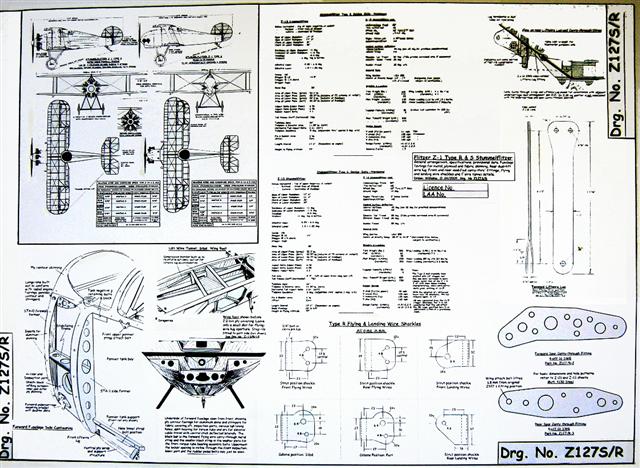

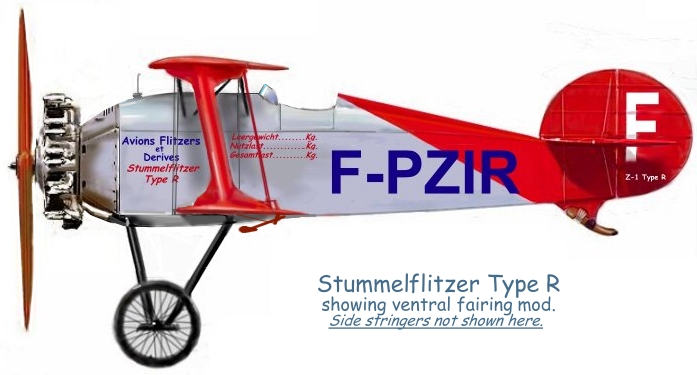 |
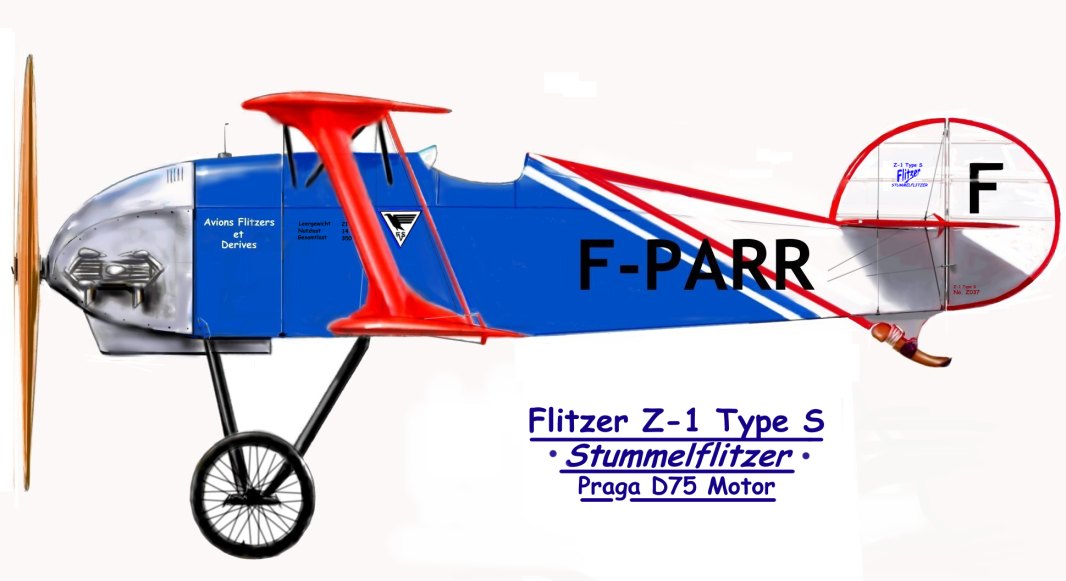 |
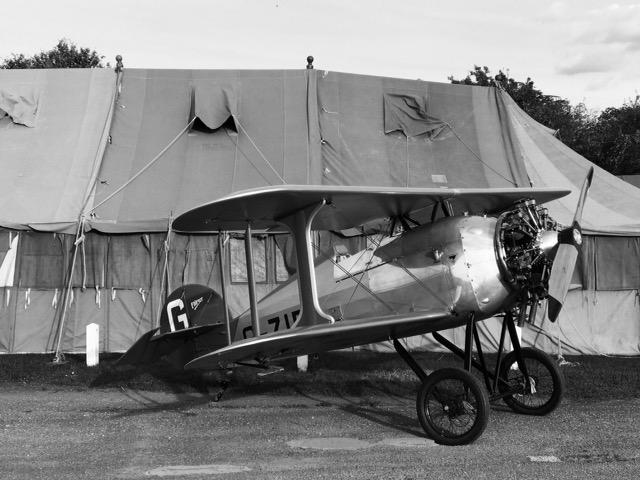 |
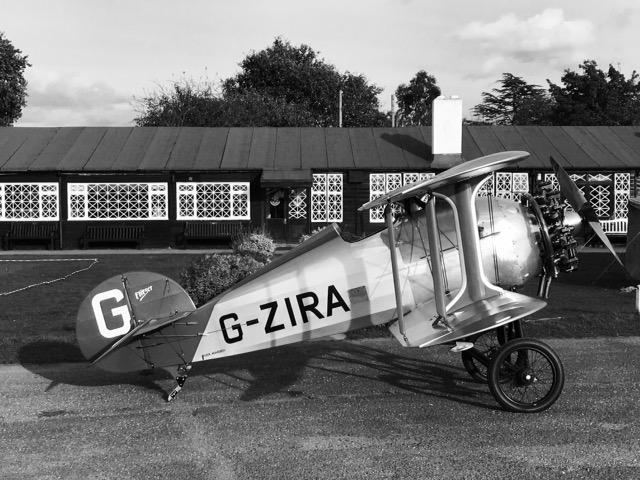 |
January 20, 2004
Z-1 Type S Stummelflitzer: Genesis and Evolution
The Z-1 Type S is a development of the original Z-1, the prototype Flitzer, which was the forerunner of the Z-21 and Z-21A 'widebody' plans versions. The latter differ from the original Z-1 in various small details, but the biggest difference is the incorporation of a 6% greater area tailplane, which reduces the 'trimmed'* approach speed by 5 mph, and allows a shorter take-off, and a steeper attitude to be held in climbing for terrain clearance. This tailplane is also 25% thicker in section, providing a greater reserve factor to the design.
[*The trimmed approach is defined in this case, where the basic Z-1 is not fitted with a tail-trimming system of any kind, as a comfortable and natural fixed position to hold the control column, with little load on the stick, with a constant sink rate established, the throttle being fully retarded at 1000 rpm, ie. the minimum rpm that is achievable in flight. This translates at 60 mph. IAS on the prototype (with the 'small' tailplane) and 55 mph IAS on the Z-21 (with the 'plans' tailplane), which provides a steeper approach with a better view, the elevator being powerful enough to provide a safe flare . However, 60 mph. is still recommended as an approach speed for most early flying with a Z-21, and will also be dependent on local conditions. The Type S is intended to have a trimming system.]
The Flitzer Z-1 M Meteor Racer was then commenced, which was essentially a lighter, scaled-down Z-1, with a fabric-covered rear fuselage, the same, thicker, tailplane profile but retaining the original Z-1 'rectangular' planform and original area. It had smaller wings with reduced stagger, and a slightly smaller vertical tail. It also had a shorter fuselage, and its longer engine bay could accommodate lighter engines on a longer mount (for flat-twins, such as the 1/2 VW, Carr, Weslake, J.A.P., etc.), or the standard VW motor weight on a 'standard' mount. The individual building this aeroplane was side-tracked by another project, however, and this well-built, partly completed project changed hands several times, and fell into neglect, despite my attempts to rescue it. However, it appears to be about to be resurrected once again.
Parallel to this design, I was evolving another small Flitzer variant, to the same initial specification, with reduced span wings, and this had been started before flight testing of the original Z-1 Flitzer.
The spiritual 'German' origins of the Flitzer (Speedster) marque, representing a generic 'European' sporting biplane from the 1920s, suggested the name 'Stummelflitzer', or clipped-Flitzer, and a similar term was historically used to describe a modified Habicht sailplane, the Stummelhabicht, (Stump Hawk or Short-Tailed Hawk) a clipped-wing version of the pre-war glider, which was evolved during WW2 for the training of young pilots who would then to go on to fly the Me 163 Komet rocket fighter, to gain experience of the higher wing-loadings they would soon encounter, in combat. At least one Stummelhabicht was armed with a light machine gun for firing practice!
The Stummelflitzer was essentially a Meteor, but with an all-ply covered fuselage, and was intended specifically for aerobatics. It soon grew two more ailerons, slaved from the lower wing, but after the flight testing of the basic Z-1, which had such superb handling, it was felt that the smaller Stummel was a little too radical (on the basis of 'if it ain't broke, don't fix it'), and the aeroplane grew a few inches, but was still smaller than the Z-1 (Z-21).
By now it had rounded wingtips and increased chords, top and bottom, to take advantage of deeper spars for aerobatics; the rounded tips intended to reduce tip vortices somewhat with the lower aspect-ratio, as well as the outer ribs (outboard of the 'I' interplane strut) being slimmer than the mainribs. The rounded tip also minimizes any tendency towards adverse wing twist with the full application of aileron, which is more likely with four short ailerons than with the standard long span lower wing aileron, as on the Z-21.
The next point of departure was the acquisition of a Czech Praga D75, a lightweight 75 hp. beauty, whose required installed-length outgrew the current CG range-accommodation, despite the lower engine weight, which then required increased stagger. As the fuselage was partly built, this meant a forward-raked cabane would be required, and the lower wing spar position had to be moved aft within the rib profile. The tail arm-effect was also further increased by sweeping the outer leading-edge of the stabiliser, and apart from the rudder, all control surfaces were now mass-balanced, with the elevator aerodynamically-balanced as well, to cater for higher design speeds. The Z-1 prototype had never exhibited any aerodynamic buzz, however, and controls firmed-up with increased speeds in an appropriate manner.
Finally the undercarriage now had to be raked further forward, due to the required CG shift, which introduced another weight and balance issue, but there was leeway in the engine bay weights. The fin and rudder now changed to the current elliptical profile, first to visually harmonise with the longer nose and increased stagger, but also to attempt to achieve a perceived 1:2:4 control-load relationship in terms of poundage, on ailerons, elevator, and rudder, respectively, the Z-1 being a little light on rudder pressure, which I personally like and one soon gets used to, but a firmer pressure might be achieved with a longer chord, hence the ellipse.
The UK Stummel prototype is progressing in Norfolk, along with the SK26 and another Goblin, while the French Stummel now has the Praga motor, and I have embarked on a Goblin myself. Several other Stummelflitzers are under construction, one for a Subaru, and another has been re-designed, as the Type 'R', for the superb Rotec R2800 radial of 110 hp. also in France.
I hope that this information is of assistance.
Sincerely,
Lynn Williams
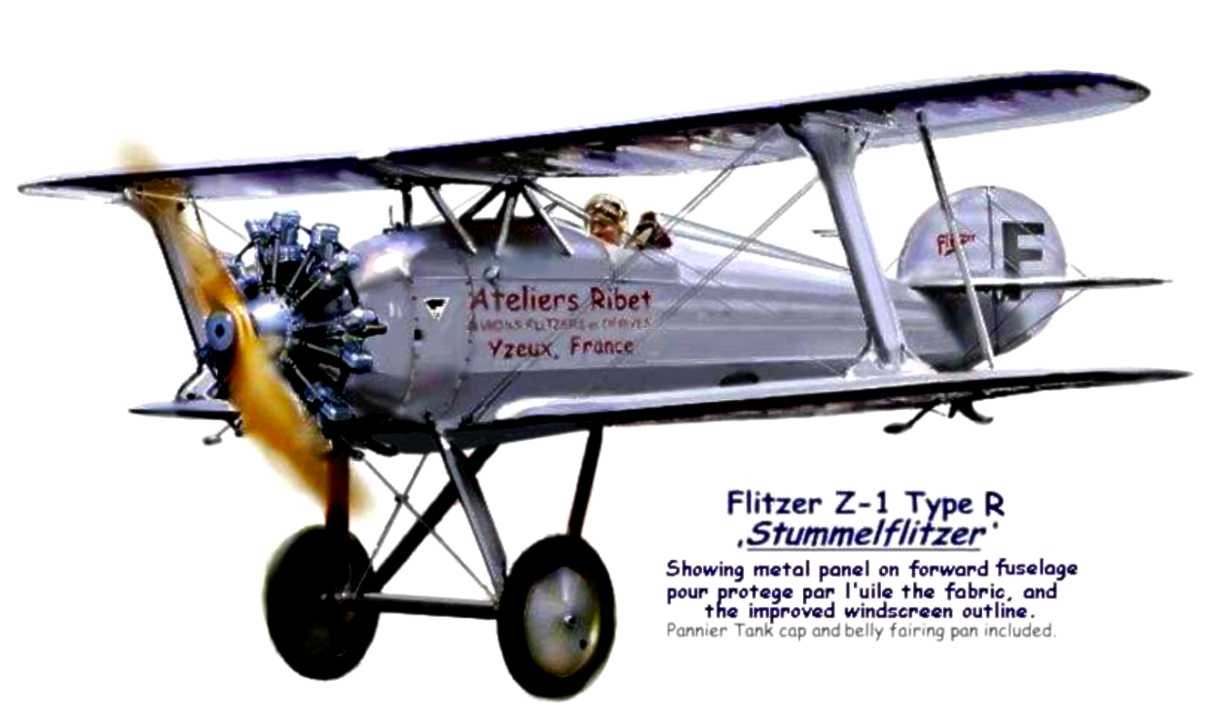
Hello Flitzerfans!
Just a quick message to accompany this preview of modified Drg., #Z-1S/18A, which shows a provisional installation representing the Australian 110 hp. Rotec R2800 Fireball seven-cylinder radial engine in the foreshortened fuselage of the Flitzer Type 'S' , the Z-1 Stummelflitzer aerobatic variant, examples of which are currently being constructed in various countries.
The attached is not a working drawing at present, and only represents what the installed radial engine might look like in the approximate location with respect to the estimated CG. The cylindrical 6 litre oil tank, complete with filler, axial tube cooler and intake, is indicated in the forward cabane bay, and the standard Flitzer fuel tank is shown in the slightly shortened tank bay.
Builders please note that the tank bay on the Z-1 Type S was previously extended by comparison with that of the Z-21, and this subsequent reduction restores it to the approximate size of the original Z-21 bay, so the standard tank will still fit.
This drawing will be issued to all Z-1 Type S builders in the near future.
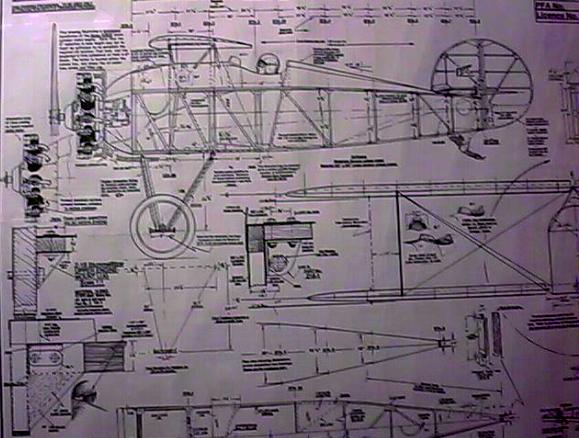
Progress on Emmanuel's Type S may be seen in the attached picture.
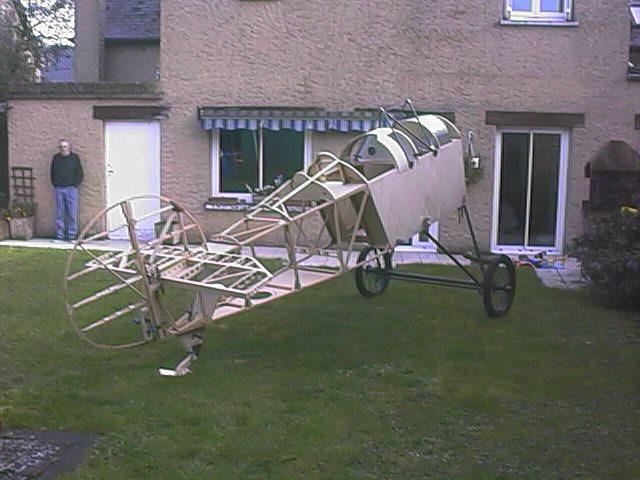
Best wishes,
Lynn
January 18, 2005
Hi Group,
Here is a scrap-section preview of a small element of the next Stummel sheet.
Lynn
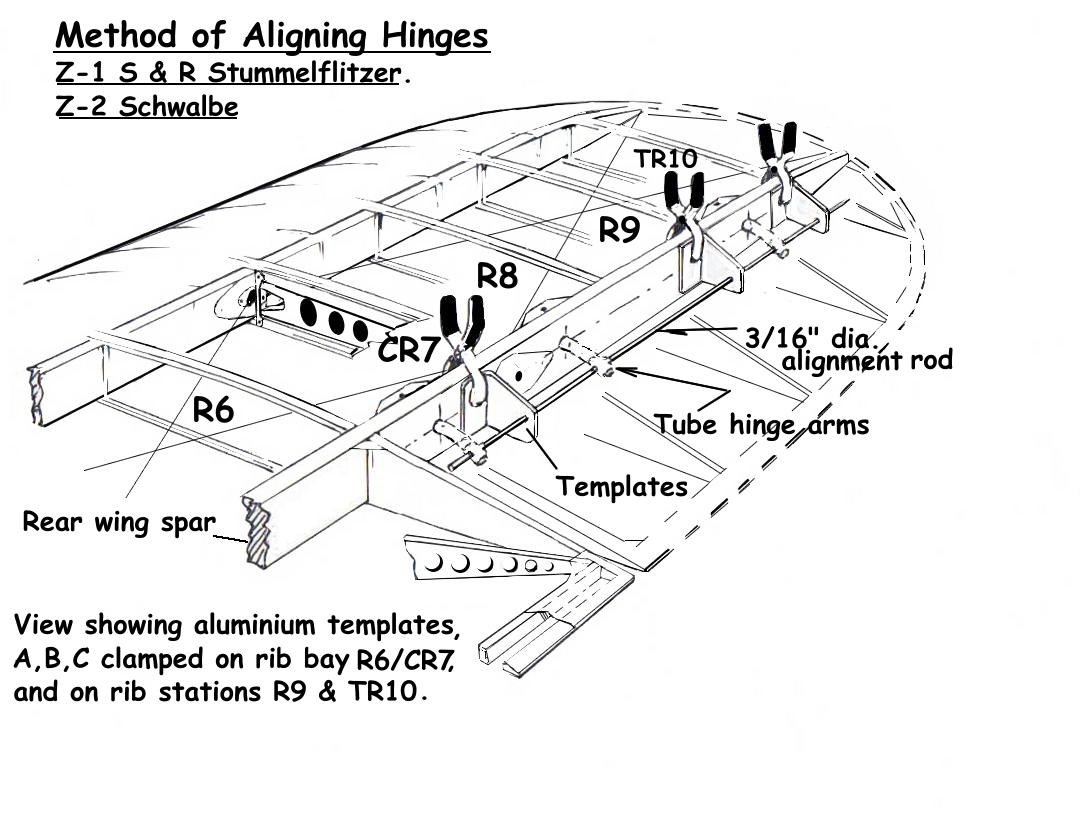
January 23, 2005
Hi Group,
I am attaching the latest drawing, which is an A1 sheet containing details of the Flitzer Z-1 Type S & R Stummelflitzer ailerons, hinges, templates and bracketry, control displacements and rigging data. This sheet introduces the system to be used on the forthcoming drawings for the Z-2, which is also a four slaved-aileron aeroplane, although the Z-2 wings are simpler than those of the Stummels, with fewer rib cross-sections to consider.
There will be at least one, possibly two further drawings, to complete the Stummel set. Builders will receive a copy of this drawing, where appropriate, in the next week.
Best regards,
Lynn
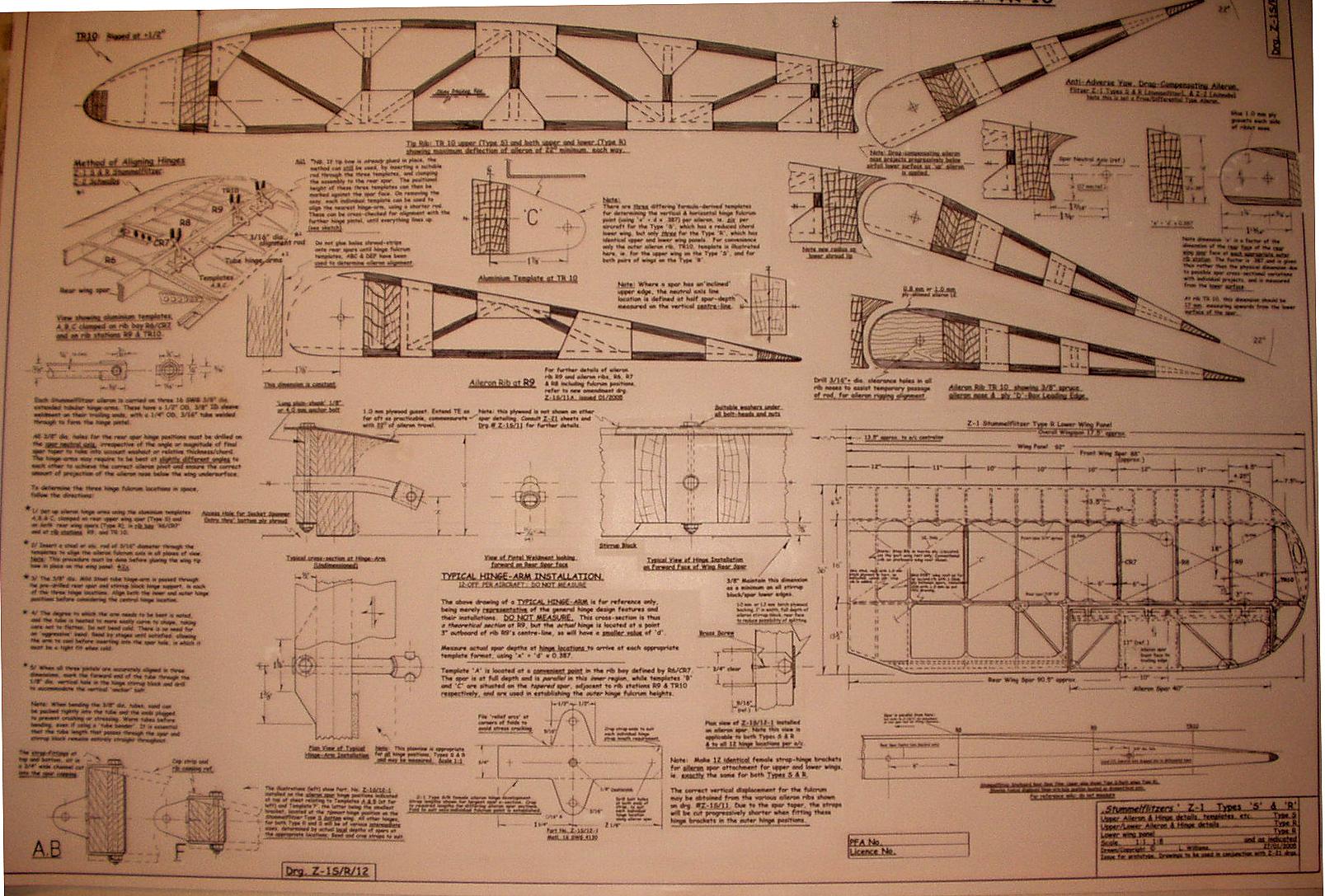
January 24, 2005
Hi Group,
This is a preview of the 'female' hinge for the Stummelflitzer ailerons. It is fairly robust at 16 SWG since the hinge bracket has been optimised for the smallest aileron hinge position, ie. the tip-most hinge on the Type S bottom wing. At the same time the strap is suitable for the thickest spar cross-section at the inboard end of the aileron spar of the upper wing on the Type S, or both wings on the Type R. Thus all 12 hinges can be laser-cut to an identical shape, and the strap ends simply cropped to shorter lengths as required, while hand-made bracket straps can be cut to the various appropriate, sizes to save on material.
The straps are secured via a single vertical 1/8" bolt passing through the stirrup block on the rear face of the aileron spar, once the fulcrum height has been established from the formula provided, the ends of the straps being bent at 90 degrees. The third 1/8" dia. hole shown is for a brass countersunk securing screw to ensure a tight fit of the bracket against the front face of the aileron spar itself. The folded strap ends sit in 1/16" x 3/4" channels in the spar capping on the aileron spar top and bottom surfaces.
This drawing and description will appear on DRG. Z-1S/12.
Regards,
Lynn Williams
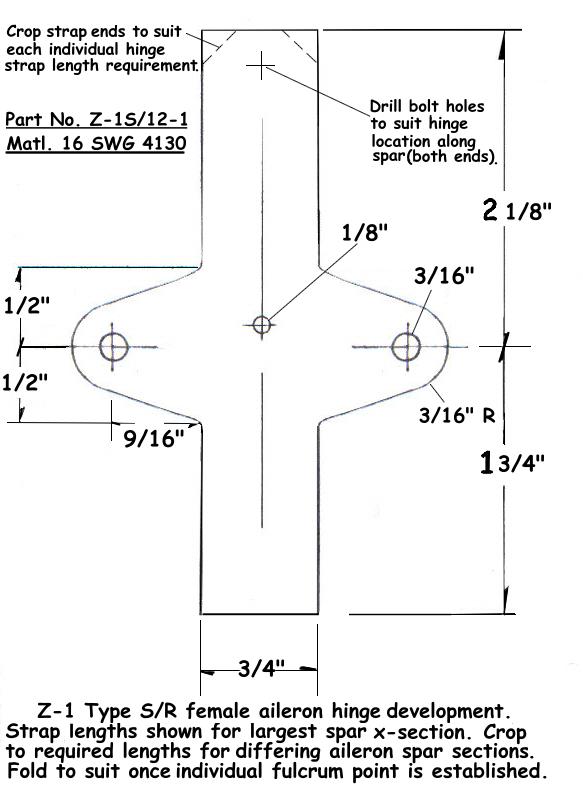
March 16, 2005
For all Type S Stummelflitzer fans.
Despite the large number of side elevations and some plan views, there has been no complete GA provided of this aeroplane yet. I came across this early and very rough GA on the PC, which shows the prototype UK Stummel with the various modifications and the Praga D engine installation.
At some stage it was drawn with slight upper-wing dihedral, and a flat lower wing, with the cabane height reduced. In this, apart from the lack of an independent upper centre-section, the frontal aspect of the wings was not unlike the Flitzer F.2 Tiger.
Lynn
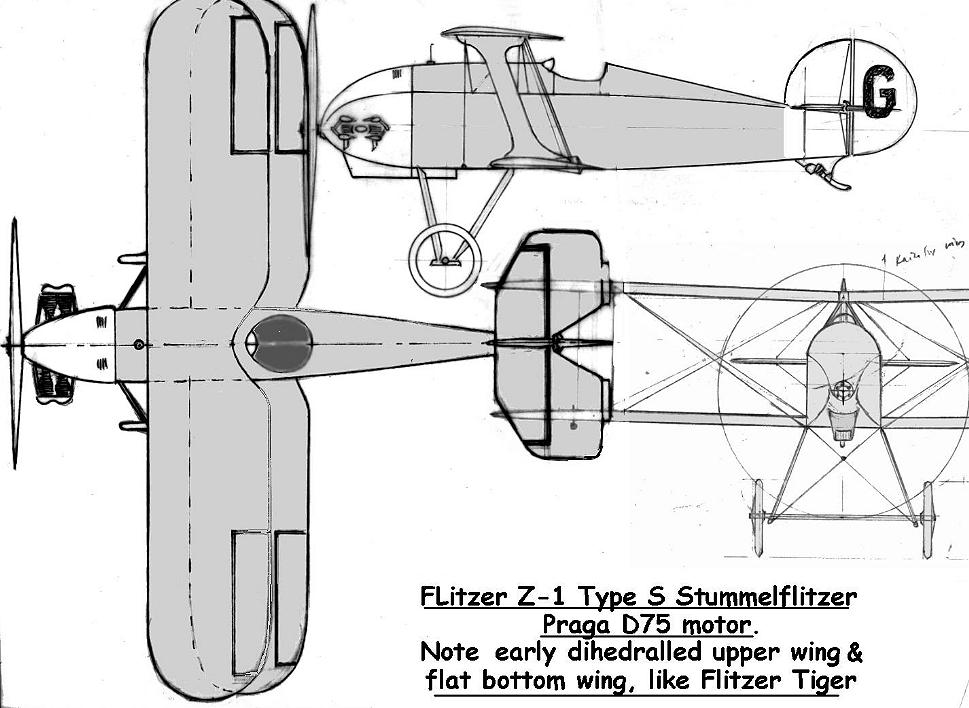
August 19, 2005
Hi Group,
This image shows the ventral fairing which takes away the otherwise severe 'flat bottom' look to the radial Stummel. This fairing also encloses the 'external' elements of the control system, etc.
The colour scheme is an early one.... I have much better ones.
Cheers,
Lynn
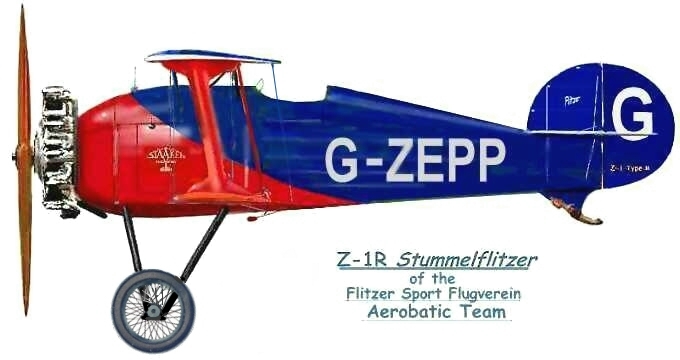
May 2, 2006
Group.
First picture of the R2800 on the front of a Stummelflitzer Type R fuselage.
Fabulous work from Herve Ribet, as expected.
Lynn
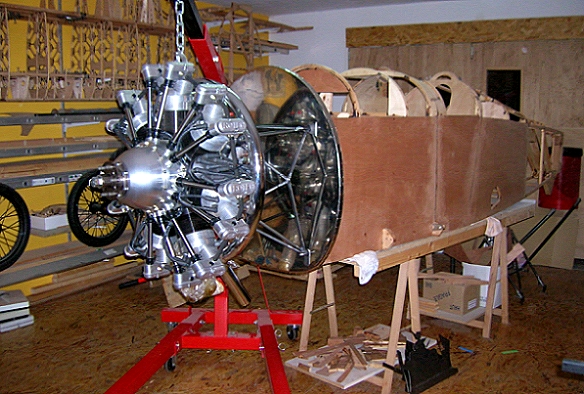
May 19, 2006
Group,
All Stummelflitzer builders please note (Types S & R), that there will be a small 16 SWG 4130 triangular plate weldment added to one side of each aileron tube hinge-arm, to further re-inforce this element against potential stress failure; Gary please note for the laser kit.
This is a suggestion from PFA Engineering, and I think that there is a better chance of the smooth passage of this design through the system with these added than without. In any case, the aileron hinge spar-strap is a weldment so the addition of this new item at the same time is not onerous, and will certainly strengthen the unit.
So 12 small plates comprising isosceles triangles with a base measurement of 2" and the two other sides measuring 1.5" are required. The tip of the triangle is cropped at an angle to accommodate the sleeve-end for the hinge pin, to suit each particular tube angle, prior to welding. One triangle welded to one side only on every hinge system - on the wing panel. Mild steel will do for this if 4130 is not available. Naturally these are only welded once the tube angle has been set for the exact vertical position of the respective aileron hinge at each location.
A new (revised) drawing will be issued to cover this mod., but meanwhile I will scan the relevant section and post this detail soon. Ed Parkin, your missing drawing will be this (revised) issue.
Best regards,
Lynn
May 23, 2006
Hi Stummelfans,
Just to update you, there will be further supplemental sheets for the Types S & R, with emphasis on the front end of the 'R', ie. the engine mount, when the weight and balance has been finally established, and details of the pannier tanks, to provide further fuel containment. For the Type S, a final sheet, that for the lower ribs, remains to be drawn full size.
If anyone hasn't received Drg. No. Z-1S/R/13, which is the mass-balance detail and aileron sheet for both types, please let me know. Roger, I don't believe you've had this one, so can you confirm please?
There is a new issue for this sheet, but the changes are so slight that for those who have the original sheet, I think it will be sufficient to send you an email attachment of the local change, which is a small triangular plate-weldment on the tubular hinge arm, as recently described.
Lynn
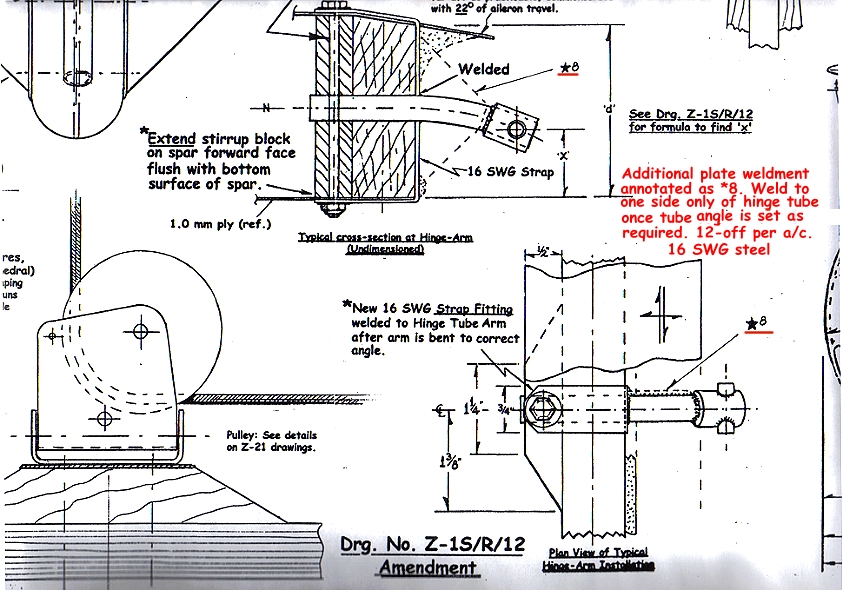
September 19, 2007
Group,
Here's an addition to the Type R plans.
It shows the seat back moved aft by 2" to accommodate taller pilots as well as the rudder pedal box extensions made bigger. This change will also allow a slightly thicker back parachute. Note that the control column may need to be cranked back a little for comfort. The R2800 radial engine may also need to be relocated on slightly longer bearers to re-establish the CG.
Bear in mind that the Type R was adapted from the Type S variant with the R2800 in mind for a pilot of only 5'4" in height. The rudder pedal box extensions were added for somewhat taller pilots but this new revision with extended pedal boxes is recommended for pilots of greater than 5' 10" in height.
Note that this drawing will be issued as part of a larger sheet which will include an alternative undercarriage arrangement with pivoting half-axles.
Best regards,
Lynn Williams
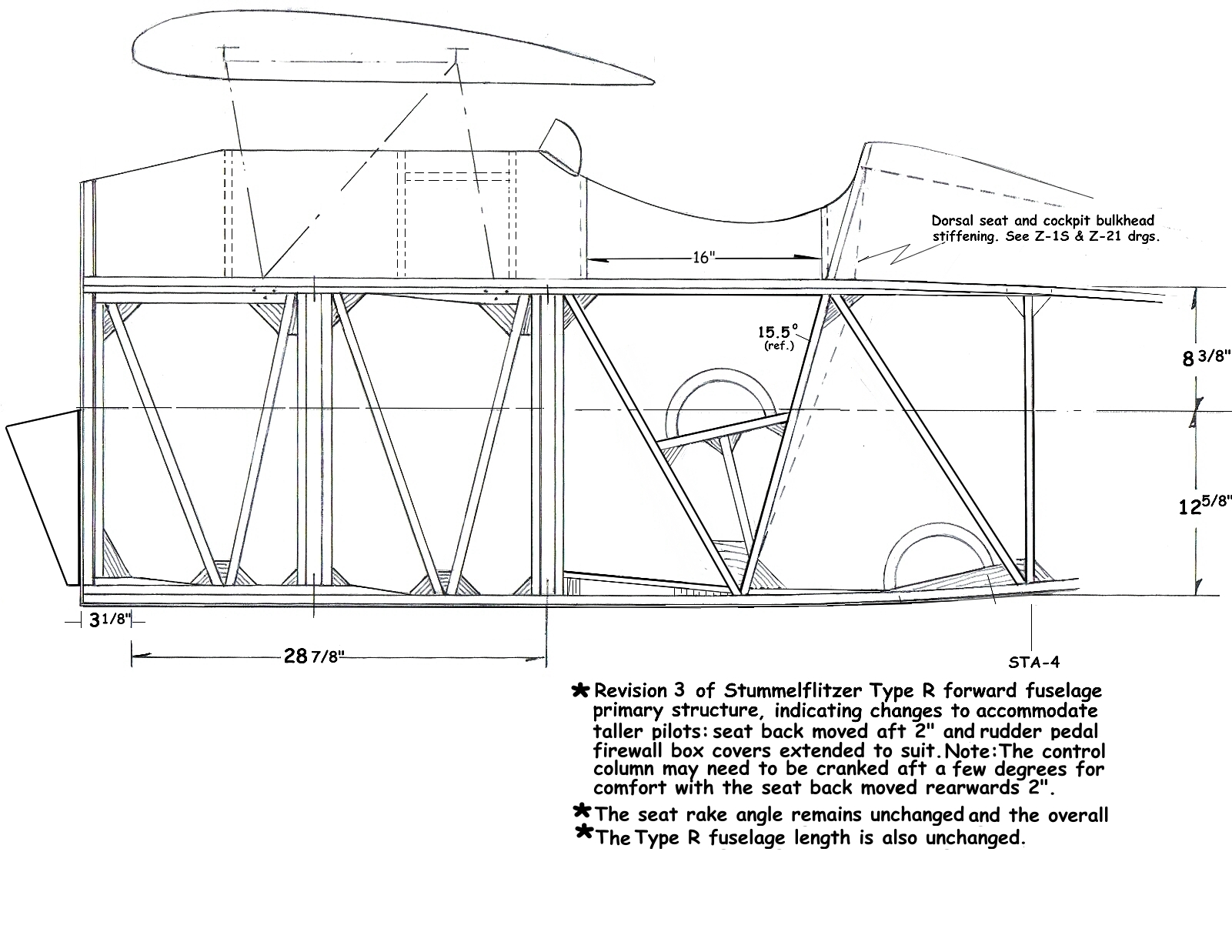
January 15, 2008 - Important image for Z-1R builders
Group,
This tank strap bracket replaces the single-bolted arrangement that fitted inside the 2.0 mm plywood tank bay decking on the Z-1R with which it shared the tank loads under negative g. With the illustrated method the plywood decking can be eliminated over the tank, being replaced by a domed aluminum tank cover for better access. This is Dudely's aeroplane.
Existing ply-decks can remain in place but access will be easier with the above.
Lynn
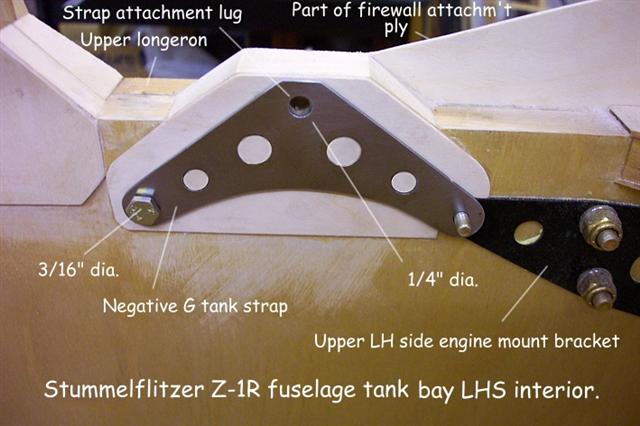
January 19, 2008 - New Cowlings?
Group,
Dudley has always wanted a fighter ever since he sold his Fury. So I think would Peter Bairstow! I've revised the basic Z-1R side elevation to incorporate a cowling having a lesser compound curve than previously shown (which exposed the R2800 crankcase) and refined the look with the addition of a small spinner.
The aeroplane now has the appearance of a late 1920s private venture prototype to a British specification for an interceptor type. It's rather like a Hawker Hoopoe, apart from the low profile fin and rudder and reduced dihedral, or even a late Gamecock evolution with a slimmed-down fuselage.
Even though this type of cowling reduces some of the interest of the radial motor itself, it is very efficient and actually simpler to make than the alternative. It redefines what the aeroplane represents to an extent, and as you see I've added machine guns and a gunsight as well as a provisional national marking.
Cheers,
Lynn Williams
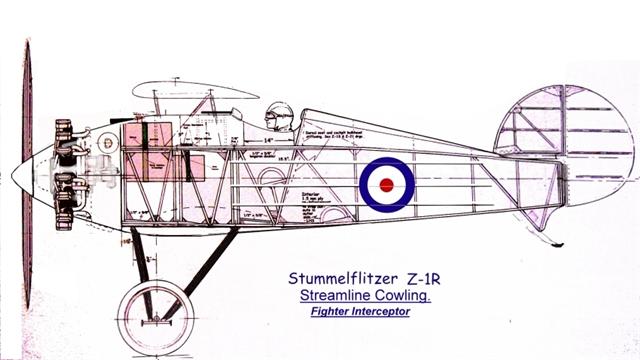
April 15, 2009
Duds,
Here's the corrected provisional specification for the Z-1R rigging and so forth. Other data can be added later based on your prototype but this should do for the analysis. I'm forwarding this to the Group as there are other 'R' builders out there. It will form part of a wider sheet of data soon.
Cheers,
Lynn
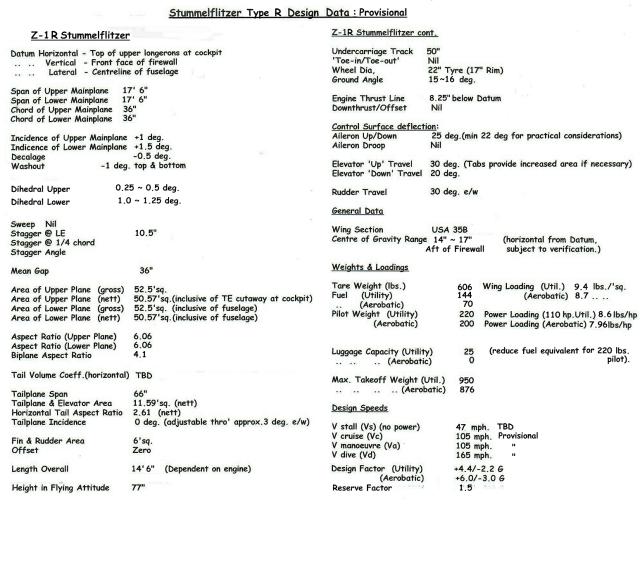 |
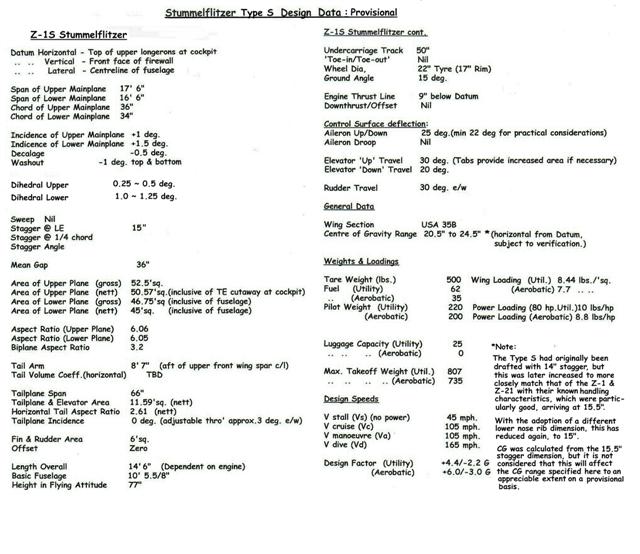 |
April 17, 2009
Group,
Here's part of the Z-1R general specification sheet which will show shackles and flying wire lugs in addition to the written specifications and general arrangement drawings for the S & R.
Cheers,
Lynn
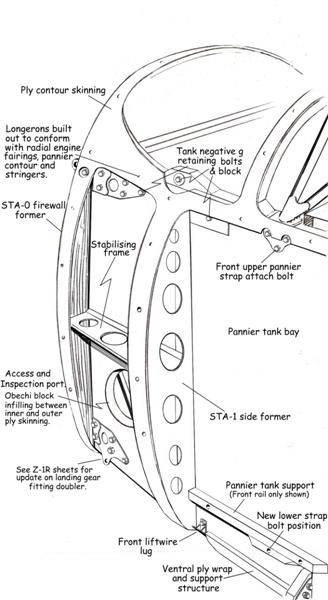
May 9, 2009 - Last Stummel Drawing
Group,
Here's a preview of the final drg. in the Z-1S & R Stummelflitzer pair.
I'll be sending these out in a few days to those builders engaged in these types. If you don't receive this sheet after a week or so please let me know, in case your project number has dropped off my 'things to complete list'. :0)
Cheers,
Lynn
